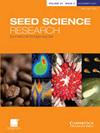亚美尼亚半沙漠地区特有全寄生植物肉苁蓉种子内生细菌的特征和多样性
IF 2.1
3区 生物学
Q2 PLANT SCIENCES
引用次数: 4
摘要
摘要我们探索了亚美尼亚盐碱和干旱栖息地的特有全寄生种肉苁蓉种子中与种子相关的细菌内生微生物组。采用培养依赖性和分子技术相结合的方法来鉴定种子内部微生物组(可培养和不可培养)。从表面灭菌的种子中,鉴定出10个门,包括256个内生细菌属。在可培养菌株中,我们还研究了植物生长促进(PGP)特性。大多数分离株是产孢、耐盐和嗜碱的芽孢杆菌。这表明山杏种子的内生细菌具有与其寄主植物的自然栖息地有关的特征。我们的研究结果证实,芽孢杆菌是生长在盐碱和干旱土壤上的植物中常见且占主导地位的内生菌。Pantoea spp.和Stenotrophomonas spp.是山杏种子中更有利的PGP内生菌。这些细菌的PGP特性,如吲哚(生长素的前体)、ACC脱氨酶和有机酸的产生,有可能提高宿主植物对自然栖息地中存在的非生物胁迫的耐受性。据我们所知,这是第一篇关于山杏细菌种子内生菌的报道。本文章由计算机程序翻译,如有差异,请以英文原文为准。
Characterization and diversity of seed endophytic bacteria of the endemic holoparasitic plant Cistanche armena (Orobanchaceae) from a semi-desert area in Armenia
Abstract We explored the seed-associated bacterial endophytic microbiome in seeds of the endemic holoparasitic species Cistanche armena from a saline and arid habitat in Armenia. A combination of culture-dependent and molecular techniques was employed for identifying the seed endomicrobiome (culturable and unculturable). From surface-sterilized seeds, 10 phyla, comprising 256 endophytic bacterial genera, were identified. Of the culturable strains, we also investigated the plant growth-promoting (PGP) traits. Most of the isolates were spore forming, halotolerant and alkaliphile Bacillus spp., indicating that the endophytic bacteria of C. armena seeds own traits related to the natural habitat of their host plant. Our results confirm that Bacillus species are common and dominated endophytes from plants growing on saline and arid soils. Pantoea spp. and Stenotrophomonas spp. are more favourable PGP endophytes in seeds of C. armena. The PGP traits of these bacteria, such as production of indole, a precursor of auxin, ACC-deaminase and organic acids have the potential to improve the tolerance of their host plants against the abiotic stresses present in their natural habitat. To the best of our knowledge, this is the first report concerning bacterial seed endophytes of the C. armena.
求助全文
通过发布文献求助,成功后即可免费获取论文全文。
去求助
来源期刊

Seed Science Research
生物-植物科学
CiteScore
3.60
自引率
4.80%
发文量
23
审稿时长
>12 weeks
期刊介绍:
Seed Science Research, the official journal of the International Society for Seed Science, is a leading international journal featuring high-quality original papers and review articles on the fundamental aspects of seed science, reviewed by internationally distinguished editors. The emphasis is on the physiology, biochemistry, molecular biology and ecology of seeds.
 求助内容:
求助内容: 应助结果提醒方式:
应助结果提醒方式:


